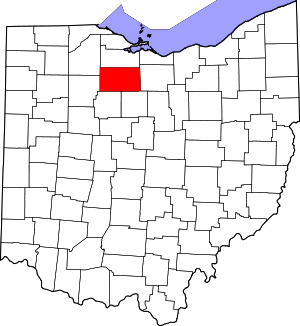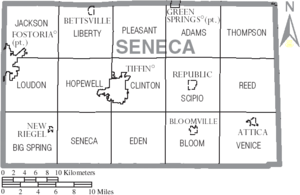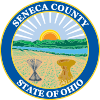Seneca County, Ohio
41°08′N 83°08′W / 41.13°N 83.13°W
Seneca County | |
|---|---|
 Location within the U.S. state of Ohio | |
 Ohio's location within the U.S. | |
| Coordinates: 41°08′N 83°08′W / 41.13°N 83.13°W | |
| Country | |
| State | |
| Founded | April 1, 1824 |
| Named for | the Seneca nation |
| Seat | Tiffin |
| Largest city | Tiffin |
| Area | |
• Total | 553 sq mi (1,430 km2) |
| • Land | 551 sq mi (1,430 km2) |
| • Water | 1.8 sq mi (5 km2) 0.3% |
| Population (2010) | |
• Total | 56,745 |
| • Density | 103/sq mi (40/km2) |
| Time zone | UTC−5 (Eastern) |
| • Summer (DST) | UTC−4 (EDT) |
| Congressional district | 4th |
| Website | www |
Seneca County is a county located in the U.S. state of Ohio. As of the 2010 census, the population was 56,745.[1] Its county seat is Tiffin.[2] The county was created in 1820 and later organized in 1824.[3] It is named for the Seneca Indians.[4]
Seneca County comprises the Tiffin, OH Micropolitan Statistical Area, which is also included in the Findlay-Tiffin, OH Combined Statistical Area.
History
The county was barely inhabited until the 1830s, but by 1860 its population had massively increased to about half the current number of inhabitants. It grew slowly thereafter, with periods of more marked increase towards the end of the 19th century, during the Great Depression and the post–World War II baby boom. In 1980 it was censused at 61,901, and has been declining since. Since about 2000, the county's population declines by about 100–300 persons annually, mainly due to a migration deficit of about 300 persons annually. This decline is projected to continue in the future.[5]
Geography
According to the U.S. Census Bureau, the county has a total area of 553 square miles (1,430 km2), of which 551 square miles (1,430 km2) is land and 1.8 square miles (4.7 km2) (0.3%) is water.[6]
Almost 80% of the county's total area is agricultural land. Some 10% is covered by forest, and the rest is mostly taken up by built-up areas and to a slightly lesser extent by pastureland.[5]
The terrain of Seneca County is nearly level, gently sloping from about 290 meters ASL in the southeast to about 210 m ASL at the edge of the erstwhile Great Black Swamp in the northwest. Most of the county's area is located between 230 and 260 m ASL however. Almost the entire county belongs to the Sandusky River drainage basin; the river itself bisects the county from north to south slightly west of its middle, running through Tiffin as it does so. There is some steeper terrain along the rivers's course, formed by the occasional ravine of its tributaries.[7]
Despite the presence of the Great Lakes which make for a somewhat milder climate in the region, Seneca County has a rather continental climate, namely after removal of the forests which once covered most of it upset the microclimate. Winters can be harsh, with plentiful snowfall due to lake-effect snow, and summers are often hot and sometimes oppressively humid, bordering on subtropical. The mostly featureless surface can result in rather extreme wind chill. In a 1906 description, the local climate was actually described as "rather unhealthful".[7]
Adjacent counties
- Sandusky County (north)
- Huron County (east)
- Crawford County (southeast)
- Wyandot County (southwest)
- Hancock County (west)
- Wood County (northwest)
Demographics
| Census | Pop. | Note | %± |
|---|---|---|---|
| 1830 | 5,159 | — | |
| 1840 | 18,128 | 251.4% | |
| 1850 | 27,104 | 49.5% | |
| 1860 | 30,868 | 13.9% | |
| 1870 | 30,827 | −0.1% | |
| 1880 | 36,947 | 19.9% | |
| 1890 | 40,869 | 10.6% | |
| 1900 | 41,163 | 0.7% | |
| 1910 | 42,421 | 3.1% | |
| 1920 | 43,176 | 1.8% | |
| 1930 | 47,941 | 11.0% | |
| 1940 | 48,499 | 1.2% | |
| 1950 | 52,978 | 9.2% | |
| 1960 | 59,326 | 12.0% | |
| 1970 | 60,696 | 2.3% | |
| 1980 | 61,901 | 2.0% | |
| 1990 | 59,733 | −3.5% | |
| 2000 | 58,683 | −1.8% | |
| 2010 | 56,745 | −3.3% | |
| 2016 (est.) | 55,353 | [8] | −2.5% |
| U.S. Decennial Census[9] 1790-1960[10] 1900-1990[11] 1990-2000[12] 2010-2013[1] | |||
2000 census
As of the census of 2000,[13] there were 58,683 people, 22,292 households, and 15,738 families residing in the county. The population density was 107 people per square mile (41/km²). There were 23,692 housing units at an average density of 43 per square mile (17/km²). The racial makeup of the county was 95.04% White, 1.76% Black or African American, 0.18% Native American, 0.38% Asian, 0.01% Pacific Islander, 1.39% from other races, and 1.25% from two or more races. 3.36% of the population were Hispanic or Latino of any race.
There were 22,292 households out of which 33.40% had children under the age of 18 living with them, 56.10% were married couples living together, 10.20% had a female householder with no husband present, and 29.40% were non-families. 24.70% of all households were made up of individuals and 10.60% had someone living alone who was 65 years of age or older. The average household size was 2.56 and the average family size was 3.04.
In the county, the population was spread out with 26.00% under the age of 18, 10.40% from 18 to 24, 27.20% from 25 to 44, 22.40% from 45 to 64, and 14.10% who were 65 years of age or older. The median age was 36 years. For every 100 females there were 98.00 males. For every 100 females age 18 and over, there were 95.70 males.
The median income for a household in the county was $38,037, and the median income for a family was $44,600. Males had a median income of $32,387 versus $22,383 for females. The per capita income for the county was $17,027. About 6.10% of families and 9.00% of the population were below the poverty line, including 9.60% of those under age 18 and 7.20% of those age 65 or over.
2010 census
As of the 2010 United States Census, there were 56,745 people, 21,774 households, and 14,870 families residing in the county.[14] The population density was 103.0 inhabitants per square mile (39.8/km2). There were 24,122 housing units at an average density of 43.8 per square mile (16.9/km2).[15] The racial makeup of the county was 93.7% white, 2.3% black or African American, 0.6% Asian, 0.2% American Indian, 1.3% from other races, and 1.9% from two or more races. Those of Hispanic or Latino origin made up 4.4% of the population.[14] In terms of ancestry, 47.6% were German, 10.4% were Irish, 8.9% were American, and 8.2% were English.[16]
Of the 21,774 households, 31.4% had children under the age of 18 living with them, 51.6% were married couples living together, 11.3% had a female householder with no husband present, 31.7% were non-families, and 26.3% of all households were made up of individuals. The average household size was 2.49 and the average family size was 2.97. The median age was 38.8 years.[14]
The median income for a household in the county was $42,573 and the median income for a family was $51,216. Males had a median income of $39,494 versus $30,286 for females. The per capita income for the county was $20,976. About 8.7% of families and 11.9% of the population were below the poverty line, including 17.9% of those under age 18 and 8.3% of those age 65 or over.[17]
Politics
| Year | Republican | Democratic | Third Parties |
|---|---|---|---|
| 2016 | 61.3% 14,825 | 30.6% 7,404 | 8.1% 1,954 |
| 2012 | 52.3% 13,243 | 44.8% 11,353 | 3.0% 747 |
| 2008 | 50.2% 13,823 | 47.5% 13,087 | 2.3% 643 |
| 2004 | 58.9% 15,886 | 40.6% 10,957 | 0.6% 148 |
| 2000 | 56.9% 13,863 | 39.1% 9,512 | 4.0% 976 |
| 1996 | 41.3% 9,713 | 42.7% 10,044 | 16.0% 3,754 |
| 1992 | 37.3% 9,763 | 35.5% 9,280 | 27.2% 7,107 |
| 1988 | 58.5% 13,704 | 40.6% 9,504 | 1.0% 222 |
| 1984 | 67.0% 16,520 | 32.1% 7,905 | 0.9% 217 |
| 1980 | 60.9% 14,172 | 31.4% 7,303 | 7.7% 1,784 |
| 1976 | 52.1% 11,730 | 44.7% 10,074 | 3.2% 712 |
| 1972 | 60.8% 13,939 | 35.7% 8,180 | 3.5% 799 |
| 1968 | 52.3% 12,040 | 39.0% 8,970 | 8.7% 2,010 |
| 1964 | 39.6% 9,536 | 60.4% 14,518 | |
| 1960 | 61.2% 15,772 | 38.8% 10,001 | |
| 1956 | 73.9% 17,728 | 26.1% 6,260 | |
| 1952 | 71.5% 17,750 | 28.5% 7,060 | |
| 1948 | 58.9% 11,493 | 40.7% 7,954 | 0.4% 77 |
| 1944 | 70.9% 15,137 | 29.1% 6,224 | |
| 1940 | 68.6% 16,272 | 31.5% 7,464 | |
| 1936 | 44.7% 9,953 | 40.4% 8,982 | 14.9% 3,324 |
| 1932 | 42.3% 9,007 | 55.9% 11,894 | 1.8% 383 |
| 1928 | 61.9% 13,369 | 37.7% 8,136 | 0.4% 82 |
| 1924 | 53.3% 9,641 | 34.8% 6,290 | 11.9% 2,160 |
| 1920 | 54.4% 10,064 | 44.2% 8,175 | 1.4% 261 |
| 1916 | 38.5% 4,301 | 57.8% 6,451 | 3.7% 409 |
| 1912 | 23.1% 2,362 | 49.6% 5,082 | 27.3% 2,796 |
| 1908 | 43.1% 4,959 | 53.3% 6,138 | 3.6% 415 |
| 1904 | 50.8% 5,291 | 45.7% 4,757 | 3.6% 372 |
| 1900 | 44.2% 4,904 | 53.6% 5,946 | 2.2% 240 |
| 1896 | 43.5% 4,988 | 55.4% 6,347 | 1.1% 130 |
| 1892 | 41.5% 4,195 | 53.2% 5,378 | 5.3% 537 |
| 1888 | 43.1% 4,165 | 54.1% 5,232 | 2.8% 271 |
| 1884 | 43.7% 4,004 | 54.1% 4,950 | 2.2% 205 |
| 1880 | 44.6% 4,008 | 53.9% 4,845 | 1.5% 132 |
| 1876 | 45.6% 3,793 | 54.3% 4,515 | 0.2% 15 |
| 1872 | 47.1% 3,128 | 52.2% 3,462 | 0.7% 48 |
Government and politics
County officials
| Office | Name | Party |
|---|---|---|
| Commissioner | Holly Stacy | Republican |
| Commissioner | Fred Zoeller | Republican |
| Commissioner | Mike Kerschner | Republican |
| Prosecutor | Derek W. DeVine | |
| Sheriff | William Eckelberry | Republican |
| Clerk of Courts | Jean Eckelberry | Republican |
| Recorder | Michael Dell | Republican |
| Treasurer | Damon Alt | Republican |
| Engineer | Mark Zimmerman | Republican |
| Coroner | Mark Akers | Republican |
| Auditor | Julie Adkins | Republican |
| Common Pleas Court Judge | Steve Shuff | Republican |
| Common Pleas Court Judge | Michael Kelbley | Democrat |
| Juvenile Court Judge | Jay A. Meyer | Republican |
Transportation
Major highways
Other highways
Airports
Communities

Cities
Villages
Townships
Census-designated places
Unincorporated communities
- Adrian
- Alvada
- Amsden
- Angus
- Berwick
- Caroline
- Carrothers
- Center
- Cooper
- Cromers
- Fireside
- Frank
- Frenchtown
- Iler
- Ink
- Longley
- Lowell
- Maple Grove
- Omar
- Reedtown
- Rehoboth
- Rockaway
- Saint Stephens
- Scipio
- Siam
- Springville
- Swander
- Watson
- West Lodi
Places of interest
Natural history
Before widespread settlement, the area of Seneca County was for the most part woodland. Besides the fringe of the Great Black Swamp in the northwest, there was also an extensive area of marshland in the Bloomville area as well as smaller patches of swamp terrain which were formed due to the county's essentially level terrain.[7] Native American inhabitants and later settlers used the region mainly for hunting fur animals, with little agriculture of note until the early 19th century.
Starting in the early-mid 19th century, the county's area was subject to wholesale deforestation. This led to massive alteration of much of the local wildlife, with grassland and farmland animals replacing the native woodland fauna. Migrant waterbirds, in ancient times commonly encountered throughout the region as they foraged in the swamps on their way south, are nowadays rare and concentrate on the few remaining waterbodies large enough to sustain them. The passenger pigeon (Ectopistes migratorius) had several roosting (and probably nesting) places in the county when it was still wooded. Removal of the forest had driven the birds away by the 1860s, foreshadowing its eventual total extinction due to large-scale logging which rendered this species unable to sustain the massive hunting pressure.[7]
Several species of waterbirds, formerly frequently encountered during migration, are only rarely seen nowadays. These include, for example, the common loon (Gavia immer), American wigeon (Anas americana), redhead (Aythya americana), canvasback (Aythya valisneria), and several species of mergansers.[7]
Landbirds were apparently less seriously affected; apart from the passenger pigeon, the ruffed grouse (Bonasa umbellus), wild turkey (Meleagris gallopavo), golden eagle (Aquila chrysaetos) and marsh wren (Cistothorus palustris) had essentially or completely disappeared by 1900. However, it is not known how many of the numerous species of New World warblers, most of which today only occur only as transient migrants, formerly bred in Seneca County.[7]
The Eskimo curlew (Numenius borealis), possibly extinct today, occurred as a transient in Ohio until about 1900; to what extent it migrated through Seneca County is not well known but even if it did it is unlikely that it was often seen after deforestation had gotten underway in earnest. The extinct Carolina parakeet (Conuropsis carolinensis) – or probably individuals of the western subspecies, the Louisiana Parakeet (C. c. ludovicianus) – may have on occasion have occurred in Seneca County as a vagrant before 1862.[7][21]
The only record of the long-billed murrelet (Brachyramphus perdix) in Ohio comes from Seneca County. A stray individual of this North Pacific auk was observed and photographed between November 12–18, 1996. The rare Kirtland's warbler (Setophaga kirtlandii) is again increasing in numbers and may occasionally range as far north as Seneca County.[7][21]
The introduced house sparrow (Passer domesticus) is common since at least the late 19th century. The ring-necked pheasant (Phasianus colchicus), another species introduced from Europe, never seems to have become really plentiful, though it has been a breeding resident since at least 1901.[7][21]
See also
References
- ^ a b "State & County QuickFacts". United States Census Bureau. Retrieved February 11, 2015.
- ^ "Find a County". National Association of Counties. Retrieved 2011-06-07.
- ^ "Ohio: Individual County Chronologies". Ohio Atlas of Historical County Boundaries. The Newberry Library. 2007. Retrieved February 14, 2015.
- ^ Ohio State University Extension Data Center (2006): Seneca County data. Version of 2006-FEB-09. Retrieved 2007-APR-28.
- ^ a b Ohio Department of Development, Office of Strategic Research (2007): Ohio County Profiles: Seneca County.
- ^ "2010 Census Gazetteer Files". United States Census Bureau. August 22, 2012. Retrieved February 11, 2015.
- ^ a b c d e f g h i Henninger, W.F. (1906). "A Preliminary List of the Birds of Seneca County, Ohio" (PDF). Wilson Bulletin. 18 (2): 47–60.
- ^ "Population and Housing Unit Estimates". Retrieved June 9, 2017.
- ^ "U.S. Decennial Census". United States Census Bureau. Retrieved February 11, 2015.
- ^ "Historical Census Browser". University of Virginia Library. Retrieved February 11, 2015.
- ^ Forstall, Richard L., ed. (March 27, 1995). "Population of Counties by Decennial Census: 1900 to 1990". United States Census Bureau. Retrieved February 11, 2015.
- ^ "Census 2000 PHC-T-4. Ranking Tables for Counties: 1990 and 2000" (PDF). United States Census Bureau. April 2, 2001. Retrieved February 11, 2015.
- ^ "American FactFinder". United States Census Bureau. Retrieved 2008-01-31.
- ^ a b c "DP-1 Profile of General Population and Housing Characteristics: 2010 Demographic Profile Data". United States Census Bureau. Retrieved 2015-12-27.
- ^ "Population, Housing Units, Area, and Density: 2010 - County". United States Census Bureau. Retrieved 2015-12-27.
- ^ "DP02 SELECTED SOCIAL CHARACTERISTICS IN THE UNITED STATES – 2006-2010 American Community Survey 5-Year Estimates". United States Census Bureau. Retrieved 2015-12-27.
- ^ "DP03 SELECTED ECONOMIC CHARACTERISTICS – 2006-2010 American Community Survey 5-Year Estimates". United States Census Bureau. Retrieved 2015-12-27.
- ^ http://uselectionatlas.org/RESULTS
- ^ Seneca County government
- ^ Seneca County Republican Party county elected officials
- ^ a b c Ohio Ornithological Society (2004): Annotated Ohio state checklist. Version of April 2004.
External links
- A Centennial Biographical History of Seneca County, Ohio. Chicago: Lewis Publishing Co., 1902.
- County website


